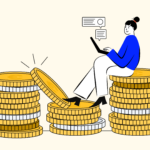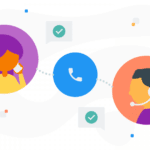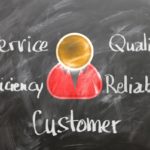14 Ways to Reduce Customer Churn for SaaS During Economic Downturn

Are you struggling to retain customers in your SaaS business amidst the recession? You’re not alone.
As interest rates rise, governments deploy new monetary policies to reduce inflation, and the entire economy goes down the pipes, more and more SaaS companies fall on hard times. And the only way out? Keeping a close eye on your metrics and doing everything you can to keep them in check.
More specifically, Customer Acquisition Cost (CAC) and churn rates are vital for ensuring your Monthly, and Annual Recurring Revenue (MRR, ARR) stay in the green.
In this post, we’ll explore 14 approaches SaaS industry leaders use to keep customers engaged and loyal, even during an economic downturn.
What is Churn Rate?
Plain and simple, churn is the percentage rate at which SaaS customers cancel their subscriptions. And while churn can be divided into several variations, SaaS companies tend to differentiate between two types: gross and net churn rates.
Gross Churn Rate tracks the percentage rate of how many customers canceled their subscriptions in a given period.
Example: If a SaaS company with 1,000 customers loses 100 in a month, its gross churn rate constitutes 10%.
Net Churn Rate is calculated by subtracting the revenue gained from up-sells and cross-sells from the revenue lost from subscription cancellations and dividing the number by the total revenue at the beginning of the period.
Example: If a SaaS company has $1,000,000 in revenue at the beginning of the month, loses $100,000 due to churn, and gains $50,000 from upsells, the net churn rate would be 5% (($100,000 – $50,000) / $1,000,000).
Why Churn is a Concern for SaaS Businesses
In B2B SaaS, churn accurately reflects customer satisfaction. Customers who are dissatisfied with the service may cancel their subscriptions and choose a different product or service. Choosing a reliable subscription management solution can help in overcoming the challenge of losing clients and streamline the entire process. And although some churn is unavoidable, when it gets too high, it leads to low revenue.
By understanding why customers leave, you can change your products or services to reduce churn and enhance customer satisfaction. SaaS businesses primarily operate on a subscription-based model and compared to other companies, customer acquisition can be expensive. It takes time to recover the investment made for acquiring customers (the CAC payback period).
Losing even one customer can lead to a considerable revenue loss. Say, for example, you only have one pricing plan at $5,000/month. In that situation, losing a single customer will cost you $60,000 annually. Not to mention that replacing them will take significant time and money in marketing.
Add to that the effort required to onboard new customers, and you’ll quickly find that investing in retaining customers is much more cost-effective.
So, all in all, an adequately low churn rate enhances MRR, customer lifetime revenue, and customer retention. It also makes the business more appealing to potential investors and venture capital funds.
Why Does Churn Happen?
Customer churn can be caused by a variety of factors. Most commonly, these include:
- bad pricing models
- changes in customers’ needs
- failure to see long-term value in your product
- failure to meet or exceed expectations
- poor customer service or response rates
- competition from other products or services
- poor product-market fit
- a weak customer onboarding process
- a lack of features that customers need or want
We could go on and on, but by now, you might have picked up that all the reasons mentioned above have one common denominator – unmet customer expectations. And like in medicine, if you want to eliminate the symptoms, you’ll need to fix the underlying issue.
To prevent churn, you should focus on improving your value proposition and ensure that your product meets customers’ needs. For example, providing excellent customer service and promptly responding to customer feedback is crucial, but creating an internal knowledge base can ensure that all representatives work to the same standard and can easily find information needed to successfully respond to customer queries.
Another important factor is ensuring a seamless onboarding process, where customers are guided through the product’s features and benefits and get enough room to ask their questions every step. Your customers will appreciate the special attention.
The inverted funnel is a helpful visual representation of a SaaS sales funnel. This illustration helps you focus on how to prevent churn and boost negative churn during economic downturns.
How 14 Industry Leaders Reduce Churn and Weather the Storm
Still a bit too generic for your tastes? Don’t worry. We took it upon ourselves to reach out to 14 SaaS industry leaders and ask them about how they approach churn and what helps them withstand the current economic climate.
1. CloudTalk.io
At CloudTalk, we know that in an economic downturn, customer churn can significantly impact the revenue of SaaS companies. To retain customers during these challenging times, it is essential to focus on proactive communication, excellent customer service, and providing value. For those interested, we discuss this topic in more detail in our ebook How to Provide Excellent Customer Service.
But without further ado, here are our nine recommendations for reducing SaaS customer churn during an economic downturn:
1. Be proactive with communication:
Keep your customers informed of any changes or updates to your product, pricing, or service. This will help build trust and confidence in your brand.
2. Focus on QBRs:
Conduct Quarterly Business Reviews (QBRs) to review progress and identify areas for growth and expansion.
3. Show clients the value of your product:
Regularly demonstrate the value of your product or service to your customers to reinforce why they chose your company in the first place. Focus on your clients’ OKRs or KPIs, what they want to achieve, and help them reach those goals using your solution.
4. Dedicate CSMs to your most valuable customers:
Assign dedicated CSMs to your most valuable customers to ensure that you meet their needs and that they get the most out of your product or service. Maintaining a lasting relationship with your customers is the key to retaining your clients. It can be also achieved through methods such as utilizing client management software, which empowers you to cultivate stronger relationships with your clients.
5. Provide excellent customer service:
Ensure your customer service team is responsive, knowledgeable, and empathetic to customer needs.
6. Analyze churn when it occurs:
Analyze the reasons behind customer churn and use that information to improve your product or service. Work closely with the product team.
7. Define a roadmap for your new customers:
Provide a clear onboarding process that outlines the steps new customers need to take to get the most out of your product or service.
8. Ask for feedback often:
Regularly solicit feedback from your customers to understand their needs and pain points, and use that feedback to improve your product or service. Ideally, the metric for this is NPS.
9. Offer flexible pricing plans:
Customers may hesitate to commit to long-term contracts during an economic downturn. SaaS companies can reduce churn by offering flexible pricing plans that allow customers to pay on a half-yearly, quarterly, or even month-to-month basis.
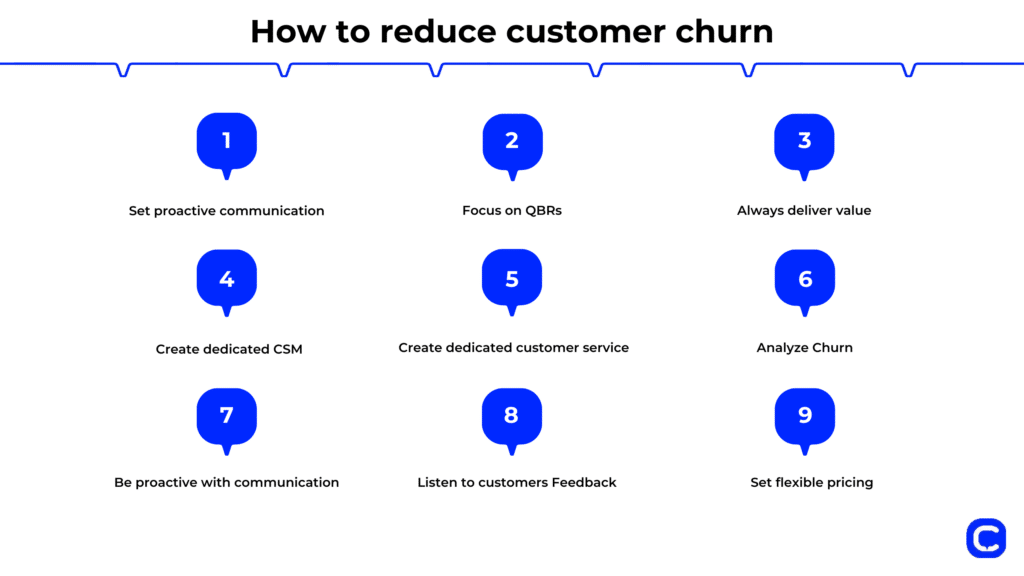
2. HubSpot.com
Thought leader: Tony Do
Position: Marketing Manager, HubSpot
“In 2023, the 3 main factors that influence customer churn are customer service, system integrations, and innovation.”
Reducing customer dissatisfaction should be the number one priority. This means having better, more efficient customer service by addressing problems proactively and making it frictionless to troubleshoot existing issues.
System integration means how vital your tools are for your customers’ operation. If you offer a single value proposition, it’s likely your customers are going to be able to find a better solution and turn away from your project. Expand your offerings and make your products and services more beneficial to your customers by elevating their systems.
Lastly, with innovation, customers are always trying to find better solutions to old problems. With the creation of AI generative tools and more cost-friendly solutions, companies have more incentive to try new tools than stick with older ones. Find ways to innovate your tools to make the customer’s life easier.”
3. Pipedrive.com
Thought leader: Mara Vicente
Position: VP of Customer Solutions
Customer churn is one of the best metrics to evaluate the health of a business. Imagine a water bottle with a hole in it – no matter how hard you try to fill it, the bottle will never be full because of a leak. The same analogy applies to businesses. Customer churn directly impacts sales, performance and hitting revenue goals. Understanding churn helps to improve the product or service and avoid the loss of customers. Usually, no or poor perception of value in your product, insufficient customer service or bad reputation is the 3 main factors influencing churn.
There are several ways to fight churn – even against economic uncertainty. Building and implementing a Voice of Customer framework helps to understand the root causes of churn and the main factors putting your customers at risk. Feeding this information back into the organization fuels the needed changes to product, pricing, packaging or processes. Measuring success and failure plays an important role in this: Pin your key pain points and differentiation points and map your customer journeys for an optimal experience, tracking engagement, effort, satisfaction and recommendation as you go. It’s also important to make everyone accountable for churn in the organization, placing it as a company-wide KPI.
During the economic downturn, the key to success also lies in revamping your value proposition to address your target customers’ current needs and using your differentiation points as key levers for acquisition and retention. When customers reach out to cancel, be ready: build a retention matrix, train your staff with the right soft skills and playbooks, and empower them to revert those cancellation intentions. Don’t forget about great client service along the way. Deliver great customer experience, doubling down on self-service and automated paths where the human touch is not critical and don’t hold back on personalization and dedicated efforts where complexity or distress plays a big role.
Finally, remember that great customer experience is a lifelong journey. Don’t take customer tenure for granted and build a health score to spot high and low engagement, usage or experience and trigger targeted actions to proactively address the risk of churn.
4. GetResponse.com
Thought leader: Abby Hehemann
Position: Director of Product Marketing
- Customer engagement: Your engaged customers are more likely to stay with you (and there’s research from Gallup that confirms that for any doubters. 😉 To increase customer engagement, you could focus on building a community around your product. This can be achieved through social media engagement, community forums, and other online platforms. Another essential component in customer engagement comes from providing regular updates on new educational or other value-add content, new features, bug fixes, and other improvements as it relates to your customers experiences with your product.
- Customer experience: A positive customer experience can go a long way in reducing churn. A focus on providing excellent customer service, addressing customer issues promptly and effectively, and continuously improving the user experience are essential in supporting retention. Offering training and tutorials can also help customers get the most out of the product, reducing frustration and churn. A survey by Salesforce affirms this, as it found that 84% of customers say that the experience a company provides is as important as its products and services.
- Pricing: Pricing can be a major factor in customer churn, particularly during an economic downturn. You could consider offering flexible pricing plans, such as pay-as-you-go or annual billing options. Providing a clear pricing structure and transparency around pricing changes can also help reduce churn. While it may be tempting to increase prices to pad your bottom line when seeing a slowdown in your net new revenue acquisition, be cautious. Mckinsey & Company offers some interesting insights on how to approach price increases during times of economic downtown and rising inflation.
In addition to these factors, it’s essential to also focus on providing value to your customers, listening to their feedback, and continuously improving your product. By focusing on customer engagement, experience, and pricing, SaaS businesses put their best foot forward in the fight against churn and position themselves for long-term success.
5. SEranking.com
Thought leader: Hanna Lebiedieva
Position: Head of Customer Support & Success, SE Ranking
“The last year has shown us the trend to reduce costs on software and subscriptions. Usually, big companies and agencies use numerous solutions simultaneously to combine the data and have different sources to compare the stats. But people started cutting budgets in 2023 already, so here’s how we keep ensuring they would choose us.”
- Focus on customers you consider your ICP (ideal customer profile) so all your efforts are concentrated on the right customers instead of trying fighting churn in the most price sensitive groups.
- Stop paying so much attention to cancellation reasons you can’t address, for example, seasonality or clients who no longer need your services just because they quit this business. Find the top cancelation reasons you can address and start working on them together with all departments.
- Make sure your Churn rates are correct, and you do not miss any details here. Each SaaS will have their own peculiarities, so you need to make sure you’re not mixing up involuntary and voluntary churn rates (for example).”
6. LiveAgent.com
Thought leader: Oliver Stasinszky
Position: Outreach Team Lead / Quality Unit
“The current economic climate is impacting businesses worldwide, and all companies need to focus on strategies for maintaining customer loyalty and reducing churn in 2023.“
Here are a few steps you can take to reduce customer churn during this turbulent time:
- Prioritize customer service: Customers who are satisfied and receive quick responses to inquiries will remain loyal to the brand, making it less likely that they will switch to a competitor in the future.
- Increase refund transparency: Providing clear refund information could encourage customers who face financial hardship to stay until they can repurchase. Consider split payments or installment plans to help them continue to use your product or service until the economy recovers.
- Create special offers for existing customers: A great way to increase loyalty amongst existing customers is by offering exclusive discounts or promotions catered to their interests and loyalty schemes that provide meaningful rewards. Additionally, incentives such as free samples or gift cards can further encourage returning customers. Investing in loyalty programs shows appreciation for existing customers and can be an effective strategy for retaining them.
- Give extra attention to at-risk customers: To detect potential churn risk, you should review customer sales history regularly. Proactively contacting customers can help develop a better relationship and increase engagement, reducing the likelihood of them defecting despite economic difficulties. Offer advice or helpful content in your personalized messages to demonstrate your value as a company.
- Listen closely for feedback: Surveys and focus groups are one of the easiest ways to acquire customer feedback. Focus groups are more interactive and involve conversations where customers discuss their thoughts about a company’s products/services. Also, surveys examine customer feedback individually, whereas focus groups identify general trends among broader populations of customers.
- Invest in innovative technologies like artificial intelligence (AI) and automation: Businesses can discover and predict individuals’ purchasing habits and preferences through artificial intelligence. Automating organizational processes allows employees to spend less time performing repetitive tasks. By doing so, businesses can save money while providing exceptional experiences tailored to each individual’s unique needs.
- Monitor changes: It is vital to monitor industry trends and changes affecting customer interactions with a product or service. Companies must act quickly if new regulations or market demands require updates. Regularly analyzing customer data can help identify patterns and areas of improvement and compare performance against competitors or industry standards. As a result, this will serve as a basis for adjusting business operations.
“Implementing strategies demonstrating value, fostering customer loyalty, and engaging customers will enable you to reach your sales goals in 2023.”
7. Nicereply.com
Thought leader: Lenka Brozmanová
Position: CMO at Nicereply
“It has been my experience that the most important factor influencing your customer churn rate is that you talk to your customers, provide them with quality content proactively, and continually monitor your customers’ behavior.”
1. Gather and categorize customer feedback
It is critical to talk to your customers and find out what they like and dislike about your business. Most companies think they know what their customer’s pain points are, but you don’t know until you ask. Ask your users how satisfied they are with the service you provide, and then ask what they think you should change & add to the service. Organize your insights into multiple categories (product feedback, suggestions regarding customer service, etc.). The responsible teams must then act on the feedback and make the necessary adjustments.
2. Use quality content to educate your customers
It is often said that you should make your product sticky. This can be accomplished by creating quality content and distributing it at the right time to the right customer. What do you want your customers to achieve with your product? What features do you want them to experience? Consider these factors and then write educational content highlighting these features and assisting your customers in achieving these milestones. The more value they get from your services, the less likely they are to churn in the future.
3. Identify & monitor red flags
Last but not least, your team should continuously monitor “red flags” that suggest a customer might leave. Determine what events occurred before customers churned in the last few months – red flags. Have they stopped logging into their account, deactivated a specific feature, or have the amount of data they collect decreased significantly (number of tickets, chats, ratings, etc.)? To prevent churn, your team needs to monitor red-flag accounts regularly and proactively intervene before they decide to leave.”
8. Kickresume.com
Thought leader: Tomáš Ondrejka
Position: CMO at Kickresume
“We’ve already experienced customer churn and learned a few techniques for reducing it. These three strategies proved the best“.
First, offer custom pricing options and try to upsell your customers to an annual plan with a significant discount. You can also allow customers to adjust their subscription plans based on their financial situation or product usage.
Second, improve your customer support to build customer loyalty and increase satisfaction. For example, your customer success team can help adjust subscription plans or provide discounts before your customers cancel the subscription. Additionally, I believe that offering value-added services, benefits, or discounts can show appreciation for your customers and help retain them.
Regarding customer churn, we see that poor customer experience, competition, and poor communication can greatly influence a customer’s decision to stay or leave. That’s why we prioritize delivering a great customer experience, staying ahead of the competition, and maintaining open and clear communication with our customers. By considering these factors, you can keep your customers happy and loyal.”
9. Billdu.com
Thought leader: Kamil Aujesky
Position: CMO at Billdu
1. Focus on delivering exceptional customer support and engagement, building strong customer relationships, and addressing their concerns or questions quickly and effectively.
2. Consider expanding your product offering to address new or emerging customer needs during the downturn.
3. Be transparent and honest with customers about any challenges or limitations your business is facing, building trust and credibility with them.
4. Monitor key metrics such as product usage and customer satisfaction, identifying potential churn risks and proactively addressing them.
5. Emphasize the value and ROI of your product, highlighting how it can help customers save money or improve their business outcomes during challenging times.
10. Spdload.com
Thought leader: Maria Shelaieva
Position: CMO at SpdLoad
Firstly, everything starts with research, as you need to find out why customer churn occurs.
Define the problem and solve it. Do market research, learn their weak and strong sides, and use it for your own customer support policy improvement.
Listen to your client’s feedback, read comments on marketplaces, and consider them.
It may happen when you target the wrong customers, or your clients don’t achieve success with your product, you are a weak competitor, your customer success may need improvement, or your product is not quality enough.
Also, make your product easy to use (if it’s not a game, of course, when the main thing is the compliance of playing).
Stay unique, keep up with your competitor, create seasonal offers to engage your customers, and use as many individual offers as possible.
11. Envato.com
Thought leader: Alina Midori Hernández
Position: Content Producer at Envato
An effective user onboarding experience
Every user onboarding experience is different, and how you approach customers will depend on your product and target audience. However, these key elements will lead you to build an effective experience that will engage new users and help you reduce the churn rate.
1. Set clear goals
Clear goals will ensure a steady plan and a smooth user journey. Before mapping the onboarding process, you can ask yourself the following questions to set your goals:
- Who are your users?
- What is your product solving for them?
- How will users learn about your product’s features and updates?
- How will you evaluate and improve your product when getting feedback?
2. Write compelling and simple copy
Users get familiar with how your product works during the onboarding phase, so lengthy explanations must be out of the picture.
The message should be straightforward, and your copy must be exciting but simple. Encourage users to try the main features and explore your product. Also, teach them where to ask for assistance if they get stuck in the process.
3. Use the right onboarding tools
There are many tools to showcase your product to new customers. Consider your tech stack, budget, and audience to choose the most adequate. Some of the most common tools to support the onboarding experience include:
- Product tours
- Tooltips
- Welcome and onboarding emails
- Videos
- Checklist and progress bars
- Knowledge base
4. Ask for feedback
The user onboarding experience should be unique and memorable, but remember that it is a learning experience for both parties.
Asking for feedback helps you track how things run throughout the process and adjust your plan to offer the best experience possible.
12. Uniqode.com
Thought leader: Atul Khiste
Position: Director, Product Management
“As a Director of Product, I would recommend the following strategies to reduce customer churn during an economic downturn.”
- Prioritize customer retention: Retaining existing customers is crucial during tough economic times. We should focus on building customer loyalty by offering incentives, personalized experiences, and superior customer service.
- Improve communication channels: Communication keeps customers engaged and informed about our product or service offerings. We should leverage multiple channels to communicate regularly and proactively with our customers.
- Enhance customer experience: We should strive to provide an exceptional customer experience by making it easy for customers to get the support they need and by being responsive and empathetic to their needs.
Regarding the main factors that influence customer churn, I would highlight the following pillars of a business:
- Pricing: Pricing is a significant factor that impacts customer decisions, particularly during an economic downturn. We should ensure that our pricing strategy is competitive and provides value for money.
- Product quality: Product quality is critical to customer satisfaction and loyalty. We should focus on delivering high-quality products that meet customer needs and expectations.
- Customer support: Customer support is another key factor that impacts customer churn. We should invest in training our support teams to be responsive, empathetic, and knowledgeable, ensuring that our customers receive timely and effective support.
13. Close.com
Thought leader: Ryan Robinson
Position: Head of Content
By leveraging market research, customer feedback, and app analytics, you can develop a clearer understanding of your ideal buyer persona, the type of person or company most apt to experience the greatest value from your product and, therefore, be less likely to churn. Adapt your marketing messaging, app experience, and sales pitches accordingly.
Let’s illustrate this concept with an example. Suppose an HR SaaS company discovers through its research that its capacity management software is best suited to HR managers at Fortune 500 companies—those most likely to stay with the company for extended periods of time. If the company’s campaigns target organizations with fewer than 250 employees. In that case, it could contribute to a high churn rate, as those individuals might not be able to take full advantage of the product’s features.
In contrast, targeting HR managers from larger firms with activities such as co-hosting webinars, using sales intelligence to pitch to Fortune 500 companies, and publishing blog posts related to capacity management for 500+ employee-strong teams can help draw in a different customer base that will gain the most from your product, reducing customer churn and increasing profitability.
14. Mydukaan.io
Thought leader: Piyush Shah
Position: Head of SEO
You can reduce customer churn by educating your users.
It is imperative to ensure that your users possess the necessary proficiency to utilize your software effectively. To derive maximum utility from your service, users must be well-versed in its optimal usage.
As a result, it is crucial to consistently provide your users with education regarding your service, even after the initial onboarding phase, irrespective of the duration of their usage. This can be achieved through various means, such as emails about new features, blog posts, or case studies illuminating how other users have leveraged your service.
Retain Customers and Win Their Loyalty
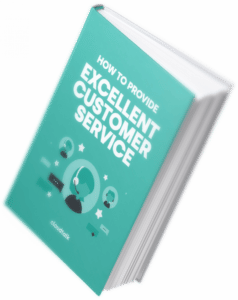
What did you find in this article?
What are the different types of churn?
Revenue churn: The percentage of subscription dollars up for renewal that a business loses over a specific time
Gross Churn Rate: The overall percentage rate at which SaaS customers cancel their recurring revenue subscriptions.
Negative churn: Negative churn indicates when a business’s monthly revenue (MRR) from existing customers exceeds the revenue lost from cancellations and downgrades (happens when customers are treated well)
Net Churn Rate: The percentage change in recurring revenue due to expansions, cancellations, and downgrades
Customer churn: how many of your existing customers are not likely to make another purchase from your business.
How to calculate churn?
Churn is usually calculated monthly, but you can also calculate it daily, quarterly, or annually. The most basic churn rate calculation is dividing your churned subscribers by the total number of subscribers.
Churn rate formula: Churn rate = Churned customers / Total customers
What is an acceptable customer churn rate?
The ideal monthly churn rate for SaaS businesses is typically below 1%, with a yearly churn rate of 5-7%. Startups and SMB-targeted businesses may struggle to meet these benchmarks. Churn rates tend to be higher in the early stages of a company, as they work to establish product-market fit and approach the right customers. At later stages, companies should focus on a scalable and repeatable strategy to keep churn under 5%, as losing 10% of customers each month would result in losing all customers within a year.
What are the best tools for reducing churn?
Tools for reducing churn include customer satisfaction surveys, retention analytics, customer loyalty programs, personalized engagement, and customer service. Customer satisfaction surveys can identify areas of dissatisfaction, while retention analytics can identify churn patterns. But the most effective tools will depend on the business and customers.












